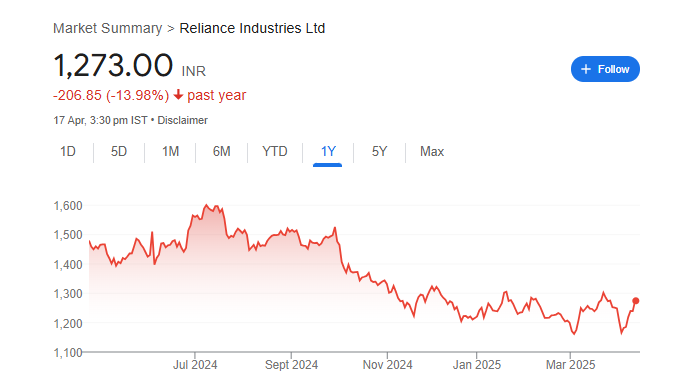Reliance Industries Share Price Target 2025 – Share Market Update
Reliance Industries Limited (RIL) is one of India’s largest and most diversified conglomerates, headquartered in Mumbai. Founded in 1966 by Dhirubhai Ambani, the company began as a textile manufacturer and has since expanded into various sectors, including energy, petrochemicals, natural gas, retail, telecommunications, and digital services. RIL operates the world’s largest refining complex in Jamnagar and has a significant presence in the petrochemical industry. Reliance Industries Share Price on NSE as of 21 April 2025 is 1,273.00 INR.
Current Market Overview Of Reliance Industries Share
- Open: 1,240.20
- High: 1,280.20
- Low: 1,227.60
- Mkt cap: 17.26LCr
- P/E ratio: 24.90
- Div yield: 0.39%
- 52-wk high: 1,608.80
- 52-wk low: 1,114.85
Reliance Industries Share Price Chart

Shareholding Pattern For Reliance Industries
- Promoter: 50.13%
- FII: 19.15%
- DII: 19.1%
- Public: 11.61%
Reliance Industries Share Price Target Tomorrow
| Reliance Industries Share Price Target Years | Reliance Industries Share Price Target Months | Reliance Industries Share Price |
| Reliance Industries Share Price Target 2025 | April | ₹1300 |
| Reliance Industries Share Price Target 2025 | May | ₹1340 |
| Reliance Industries Share Price Target 2025 | June | ₹1380 |
| Reliance Industries Share Price Target 2025 | July | ₹1420 |
| Reliance Industries Share Price Target 2025 | August | ₹1460 |
| Reliance Industries Share Price Target 2025 | September | ₹1500 |
| Reliance Industries Share Price Target 2025 | October | ₹1540 |
| Reliance Industries Share Price Target 2025 | November | ₹1580 |
| Reliance Industries Share Price Target 2025 | December | ₹1610 |
Key Factors Affecting Reliance Industries Share Price Growth
Here are six key factors influencing the growth of Reliance Industries Limited’s (RIL) share price:
1. Strong Financial Performance
In the third quarter of FY25, RIL reported a 7% year-on-year increase in consolidated net profit, reaching ₹18,540 crore. Revenues from operations also grew by 7% to ₹2.43 lakh crore. This consistent financial growth supports investor confidence and can positively impact the share price.
2. Growth in Digital and Retail Segments
Reliance’s digital arm, Jio Platforms, achieved a 26% year-on-year growth in net profit, while revenues improved by 19%. Additionally, the retail business has shown strong performance, contributing significantly to the company’s overall profitability.
3. Expansion into Green Energy
RIL is investing heavily in renewable energy, including solar photovoltaic and green hydrogen production. The company expects its new energy business to rival the profitability of its established oil-to-chemicals segment within the next 5-7 years.
4. Strategic Partnerships and Agreements
Reliance has signed a 10-year agreement with Rosneft to purchase discounted crude oil, enhancing its refining margins and ensuring a stable supply. Such strategic deals can improve operational efficiency and profitability.
5. Positive Analyst Outlook
Global brokerage Goldman Sachs maintains a ‘Buy’ rating on RIL, with a price target indicating a 31% upside potential. Analysts attribute this optimism to expected earnings growth driven by retail recovery and Jio’s performance.
6. Diversification Across Sectors
RIL’s presence in various sectors, including energy, telecommunications, retail, and digital services, provides a diversified revenue stream. This diversification helps mitigate risks associated with any single industry and supports long-term share price growth.
Risks and Challenges for Reliance Industries Share Price
Here are six key risks and challenges that could influence the share price of Reliance Industries Limited (RIL):
1. Stock Volatility and Recent Declines
RIL’s stock has experienced notable volatility, hitting a 52-week low of ₹1,115.55 and declining by approximately 10.78% over a six-day period. Such fluctuations can affect investor confidence and impact the share price.
2. Challenges in the Oil-to-Chemicals (O2C) Segment
The company’s O2C business, which contributes significantly to its revenue, has faced pressure due to global oversupply and reduced margins. This has led to a 5% decline in net profit in the second quarter of FY25.
3. High Capital Expenditure and Debt Levels
RIL’s substantial investments in new projects, including green energy initiatives, have increased its debt levels. The company is seeking up to $3 billion in loans for debt refinancing, which could raise concerns about financial stability.
4. Regulatory and Legal Challenges
A unit of RIL risks penalties for not establishing a planned battery cell plant, part of India’s initiative to reduce import dependence. Such regulatory issues can affect the company’s operations and reputation.
5. Delays in IPOs of Key Subsidiaries
Despite plans to list its consumer-facing businesses like Jio and Reliance Retail, delays in these IPOs have led to investor uncertainty. Timely execution of these listings is crucial for unlocking shareholder value.
6. Increased Competition in Core Businesses
RIL faces growing competition in its core sectors, including retail and telecommunications. This heightened competition can impact market share and profitability, influencing the company’s share price.
Read Also:- Arihant Capital Share Price Target 2025 – Share Market Update

